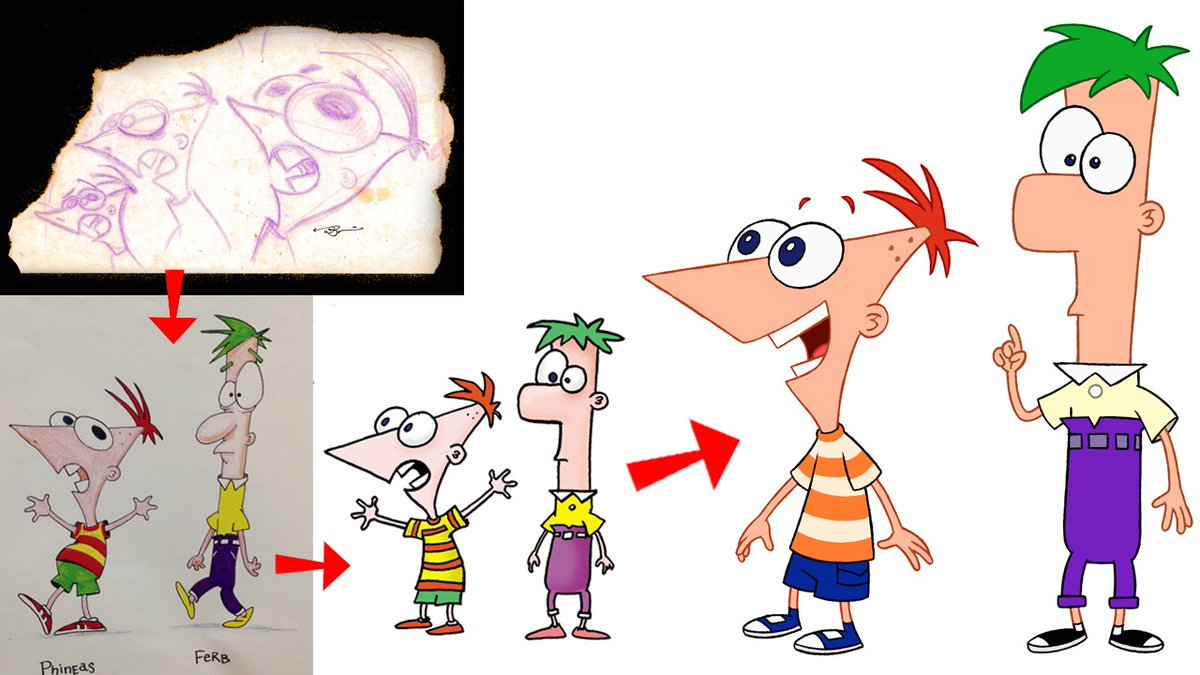You know what, let's talk about Phineas. Phineas makes for a good litmus in character design — in terms of what people think should work and shouldn't work.
Spoiler: Phineas works.
Spoiler: Phineas works.
He's an easy design to pick on. "How could that head possibly work?" "Come on, really? A triangle for a head?" "Jesus is that ugly." "Where is his nose???"
"It's so flat, sooo garish."
Millions of kids and adults would disagree with you.
(including me)
"It's so flat, sooo garish."
Millions of kids and adults would disagree with you.
(including me)
It's hard to track down a proper full model sheet to study, but I was able to google-retrieve these unfortunately cropped sheets.
Yes, there is some 3dimensional underlying logic to his structure, which shows more when he's drawn at slight angles. Including a front-facing angle.
Yes, there is some 3dimensional underlying logic to his structure, which shows more when he's drawn at slight angles. Including a front-facing angle.
Some of you may be privately lamenting, "but, Bob, come on—that face only works in profile! The front-view is so off-putting and unappealing!"
Like I cited above, they do have a front-facing solution. (They just do use it much.)
And, SpongeBob has the same opposite issue.
Like I cited above, they do have a front-facing solution. (They just do use it much.)
And, SpongeBob has the same opposite issue.
Plenty of great cartoon character designs have an angle that doesn't work so hot. So they're typically only reserved for special occasions. The Simpsons 'overbite mouth' certainly has been well-documented for not working hot in front-view.
Bart and most other Simpsons characters are *optimally* designed to work in 3/4 front view, and most others. In fact, I'd argue most cartoon drawings sell best at 3/4 front view. It's the most bang-for-your-buck way to draw a cartoon.
Love her or hate her, kids love Dora the Explorer. You'd be hard pressed to see her drawn in profile, because she was designed to *always* be looking at the screen. That's the whole philosophy of the show.
I once challenged folks to find profiles https://twitter.com/bobjinx/status/1222003651935338496
https://twitter.com/bobjinx/status/1222003651935338496
I once challenged folks to find profiles
 https://twitter.com/bobjinx/status/1222003651935338496
https://twitter.com/bobjinx/status/1222003651935338496
In summary, the 'Phineas doesn't work in front-view' is kind of a non-starter for me. Because he wasn't designed to be optimized for that view. And in spite of that, look at how fun the Phineas toys are! They've managed to cone it up.
One of the co-creators of Phineas and Ferb, Dan Povenmire, gave some background on the genesis of Phineas in an interview with AWN in 2008. Drawing direct inspiration from Tex Avery's use of geometry in design. https://web.archive.org/web/20090821170014/http://mag.awn.com/index.php?ltype=pageone&category2=&article_no=3534&page=3
See Tex's 'Crazy Mixed-Up Pup' (1955)
I can see the connection. Tex is really pushing flat shape design at this point, like a lot of mid-century animation.
https://www.dailymotion.com/video/x1hac6w
I can see the connection. Tex is really pushing flat shape design at this point, like a lot of mid-century animation.
https://www.dailymotion.com/video/x1hac6w
Wrapping up. Phineas & Ferb is almost universally loved as a cartoon. The writing is certainly clever, but I think a lot of credit is due to a unique take on a 'cartoon boy' design. Instantly recognizable, and fun for kids to draw I suspect.
Read more:
https://medium.com/innovation-insider/character-design-innovation-with-crayons-and-butcher-paper-c6ff5728d25c
Read more:
https://medium.com/innovation-insider/character-design-innovation-with-crayons-and-butcher-paper-c6ff5728d25c

 Read on Twitter
Read on Twitter





















